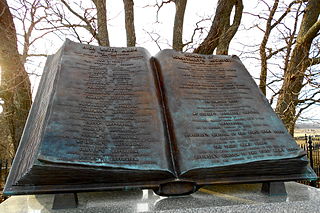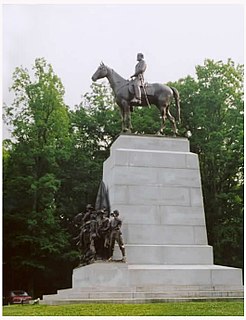 W
WThe monuments of the Gettysburg Battlefield commemorate the July 1 to 3, 1863 Battle of Gettysburg in the American Civil War. Most are located within Gettysburg National Military Park; others are on private land at battle sites in and around Gettysburg, Pennsylvania. Together, they represent "one of the largest collections of outdoor sculpture in the world."
 W
WThe 11th Mississippi Infantry Statue is a Gettysburg Battlefield memorial commemorating a Confederate regiment with a bronze sculpture of a flagbearer.
 W
WThe Alabama State Monument, also known as the Alabama State Memorial, is an Alabama memorial in Gettysburg National Military Park that commemorates the state's Confederate units that took part in the Battle of Gettysburg. It is located in an area that was occupied by Evander M. Law's Alabama Brigade prior to their attack on the Round Tops on July 2, 1863. It was dedicated by the Alabama Division of the United Daughters of the Confederacy on November 12, 1933.
 W
WThe Eternal Light Peace Memorial is a 1938 Gettysburg Battlefield monument dedicated on July 3, 1938, commemorating the 1913 Gettysburg reunion for the 50th anniversary of the 1863 Battle of Gettysburg on July 3, 1913. The natural gas flame in a one-ton bronze urn is atop a tower on a stone pedestrian terrace with views from the terraced hill summit over about 400 sq mi (1,000 km2), and the flame is visible from 20 mi (32 km) away.
 W
WThe Friend to Friend Masonic Memorial is a Gettysburg Battlefield monument depicting the "Armistead-Bingham incident" after Pickett's Charge in which Union Army Captain Henry H. Bingham assisted mortally wounded Confederate Brigadier General Lewis Addison Armistead, both Freemasons. Although Armistead's sword was captured and later returned in 1906, Armistead entrusted other personal effects with Bingham after Armistead was shot twice. En route to a Union field hospital on the Spangler Farm, where he would die two days later, Armistead briefly met Capt. Bingham, and after learning that he was on the staff of General Winfield Scott Hancock, a Freemason as well, he asked Bingham to pass along the items with a message to Hancock. Having been wounded at about the same time, General Hancock, who was a "valued friend" of Armistead's from before the war, when they served together in the Federal army, would not see Armistead before he died.
 W
WThe High Water Mark of the Rebellion Monument is a Gettysburg Battlefield memorial which identifies the Confederate Army of Northern Virginia units of the infantry attack on the Battle of Gettysburg, third day, with a large bronze tablet, as well as the Union Army of the Potomac's "respective troops who met or assisted to repulse Longstreet's Assault." The memorial is named for the line of dead and wounded of Pickett's Charge which marked the deepest penetration into the Union line at The Angle when "4,500 men threw down their arms and came in as prisoners". The line is now generally marked with unit monuments which are also historic district contributing structures. The High Water Mark monument is accessible via Hancock Avenue which has parking spaces alongside, and a path leads to the site from a parking lot at the former Cyclorama Building at Gettysburg, which served for fifty years as a Gettysburg Battlefield visitor center by the National Park Service until it was demolished in 2013.
 W
WThe 44th and 12th New York Infantry Monument is a Gettysburg Battlefield memorial erected near the summit of Little Round Top to commemorate combat in the Battle of Little Round Top. The castellated building is the largest monument to a regiment on the battlefield, is the 1st of only 2 Battle of Gettysburg memorials with observation decks, and supplemented the Gettysburg Battlefield Memorial Association wooden towers on Big Round Top and East Cemetery Hill. The July 3, 1893, memorial dedication was the site of an altercation against photographer William H. Tipton by Gen. Sickles, who was served a court writ the following day and was forced out of the New York Monuments Commission in 1912 after malfeasance.
 W
WThe North Carolina Monument is a North Carolina memorial of the American Civil War commemorating the 32 Carolina regiments in action at the Battle of Gettysburg. The monument is a public artwork by American sculptor Gutzon Borglum located on Seminary Ridge, West Confederate Avenue, in the Gettysburg National Military Park.
 W
WThe 72nd Pennsylvania Infantry Monument is an 1891 statuary memorial on the Gettysburg Battlefield. It is located on Cemetery Ridge, by The Angle and the copse of trees, where Union forces – including the 72nd Pennsylvania Infantry – beat back Confederate forces engaged in Pickett's Charge.
 W
WThe Pennsylvania State Memorial is a monument in Gettysburg National Military Park that commemorates the 34,530 Pennsylvania soldiers who fought in the July 1 to 3, 1863 Battle of Gettysburg during the American Civil War. The memorial stands along Cemetery Ridge, the Union battle line on July 2, 1863. Completed in 1914, it is the largest of the state monuments on the Gettysburg Battlefield.
 W
WThe Soldiers' National Monument is a Gettysburg Battlefield memorial which is located at the central point of Gettysburg National Cemetery. It honors the battle's soldiers and tells an allegory of "peace and plenty under freedom … following a heroic struggle." In addition to an inscription with the last 4 lines of the Gettysburg Address, the shaft with 4 buttresses has 5 statues:A large statue representing the concept of Liberty surmounts the pedestal. Eighteen large bronze stars circling the pedestal below this statue represent the eighteen Union states with buried dead. A statue is located at each corner near the base. They represent War, History, Peace, and Plenty. War is represented by a statue of an American soldier who recounts the story of the battle to History. In turn, History records, with stylus and tablet, the achievements of the battle and the names of the honored dead. A statue of an American mechanic and his tools illustrates Peace. Plenty is a female figure with a sheaf of wheat and the fruits of the earth that typify peace and abundance as the soldier's crowning triumph.
 W
WThe Virginia Monument is a Battle of Gettysburg memorial to the commonwealth's "Sons at Gettysburg" (Battlefield) with a bronze statue of Robert E. Lee on his horse Traveller and a "bronze group of figures representing the Artillery, Infantry, and Cavalry of the Confederate Army". The equestrian statue is atop a granite pedestal and the group of six standing figures is on a sculptured bronze base with the figures facing the Field of Pickett's Charge and the equestrian statue of Union General George G. Meade on Cemetery Ridge.